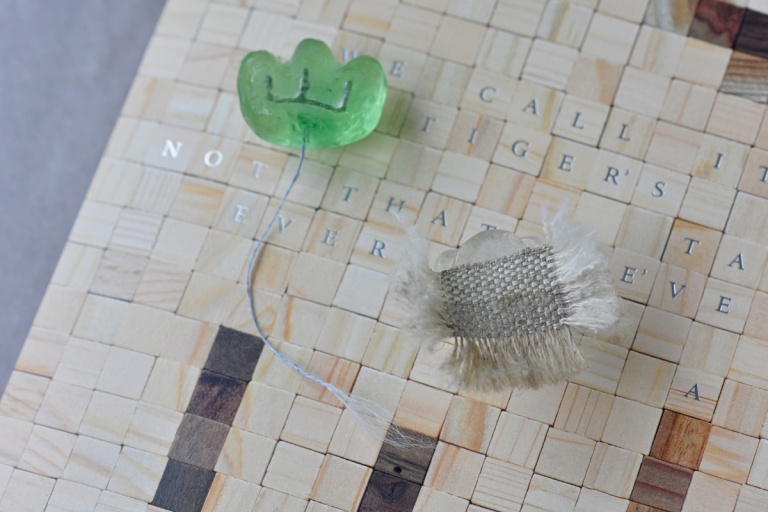Exhibition
We call it Tiger’s Tail River, not that we’ve ever seen a real tiger

INSTALLATION VIEW “We call it Tiger’s Tail River, not that we’ve ever seen a real tiger“, 2025. Courtesy of the Artist and Tomio Koyama Gallery.
Tomio Koyama Gallery Tennoz is pleased to announce an exhibition commemorating the publication of Mika Kato’s first monograph, “We call it Tiger’s Tail River, not that we’ve ever seen a real tiger.”
Mika Kato held her first solo exhibition in 18 years at our Roppongi space in June 2024. Her works have undergone a significant transformation as a result of changes in her own life and sensibilities. This exhibition featured photographic works that captured her own sculptural pieces, alongside numerous small works depicting everyday moments, scattered atop a massive, meandering wooden mosaic table that curved like a tiger’s tail, using stone, wood, glass, and other materials as supports. Kato’s new body of work, poetically woven together over an extended period of time through the perspective of love and compassion for nature, living things, and family within the context of everyday life, resonated deeply with viewers.
This monograph is a valuable publication that represents a condensation of Kato’s artistic journey to date. It documents this solo exhibition, her past works, essays, and interviews with the artist.
On the occasion of this exhibition, both the standard edition of the catalog and a special limited edition of 50 copies will be on sale. Also on display and for sale will be the wooden block artworks used for the cover of the catalogue, drawings, several pieces from Kato’s 2024 solo exhibition in Roppongi, and a set of 50 small works accompanying the special edition of the monograph.
Kato herself had the following thoughts regarding the creation of the small works for the special edition.
————————————————–
I am creating fifty small pieces, each of which can fit in one hand. Each one uses materials found in everyday life: grass fuzz and roots, newsprint, objects salvaged from beaches and riverbanks, embroidery threads lying dormant at the back of a sewing box, the parts of fruits that are inedible. Even colorful shavings from children’s pencils are waiting for their turn. I also use glass made with the ‘pâte de verre’ technique of pressing crushed or powdered glass into a mold.
My creative process lets things unfold as they will. Today, I took apart scraps of oil painting canvas. Untwisting the threads, separating them, and gently teasing them with a needle to avoid cutting the fibers resulted in countless fine, shimmering strands. They were so thin — like steam dissolving into the air — that I couldn’t see where their ends were. I found myself wondering if, back when this hemp was still growing in the ground, its sky blue flowers swaying and fluttering around, these strands had served as straws that drew water up — and suddenly, an image surfaced of myself being sucked into the overgrown grass that lay beyond the window.
These objects can be detached from the wooden mosaic in the background. Since they attach with magnets, you can also choose to insert iron thumbtacks into the wall, and mount just the object part alone. In addition, some pieces can be removed and played with. I hope that they can be kept close by, within someone’s reach, like a kind of talisman.
ーMika Katoー
————————————————–
A gem of a book, where the depth of universal everyday life that transcends eras connects with each viewer’s own senses — we hope you will take this opportunity to pick it up and see for yourself.
2025. 10. 18. (Sat) – 2025. 11. 08. (Sat)
Tomio Koyama Gallery (Tennoz)